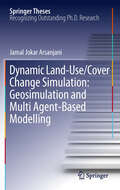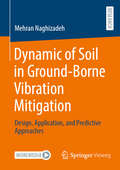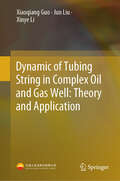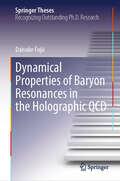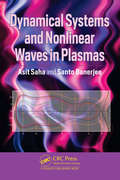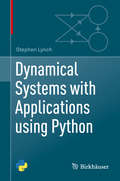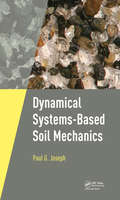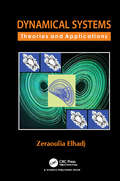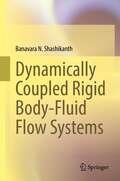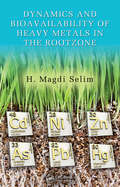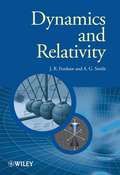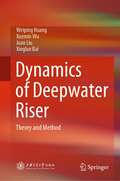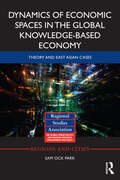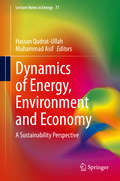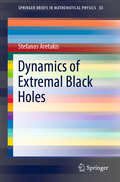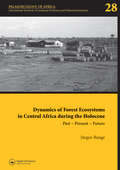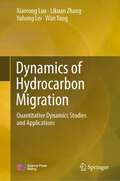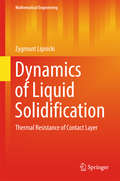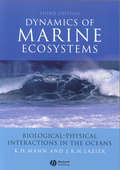- Table View
- List View
Dynamic land use/cover change modelling
by Jamal Jokar ArsanjaniThe thesis is an original and novel contribution to land use/land cover change analysis using methods of geosimulation and agent-based modeling. The author implements several traditional methodologies of land use change by means of remote sensing and GIS techniques. An Agent-Based Model was developed in order to simulate land use change in the Tehran metropolitan area, comparing the outcomes of each particular methodology. All methods are compared, and advantages and disadvantages discussed.
Dynamic of Soil in Ground-Borne Vibration Mitigation: Design, Application, and Predictive Approaches
by Mehran NaghizadehIn the heart of big cities, a less obvious challenge exists right under our feet. The everyday activities of city life, like traffic, construction, and industrial work, do more than just create noise. They send vibrations through the ground, which can be problematic, sometimes even destabilizing buildings and affecting the people who live there. This modern issue needs a modern solution. This book introduces the concept of trenches filled with a material called geofoam, an innovative method to control these ground vibrations. Mehran Naghizadeh delves into a detailed study to see how placing these trenches in specific locations can help protect against these vibrations. The book walks through various automated 2D and 3D models, demonstrating how the trenches can be effectively used to protect areas close to and far from the source of vibrations. The study goes beyond just explaining what these trenches are and how they work. It looks into the reasons behind their design, examining different trench shapes and how each shape helps in managing these underground vibrations. The challenge is more complex than it seems. The ground we walk on is not just a single layer but has different layers with various properties. This book takes you on a journey to understand how these layers influence the effectiveness of our vibration warriors. It’s an exploration of how every layer in the soil contributes to managing vibrations.
Dynamic of Tubing String in Complex Oil and Gas Well: Theory and Application
by Jun Liu Xiaoqiang Guo Xinye LiThis book presents dynamic response, vibration characteristics, and nonlinear behavior of complex oil and gas well string by using a combination of theoretical methods, numerical simulation, and experimental analysis. It lays both theoretical and experimental foundation for the design of oil and gas well string parameters. The theoretical methods involved mainly include Hamilton's principle, finite element method, and energy method, while experimental methods involved include similarity principle, vibration testing method, and modal analysis method. It is a valuable reference for both scholars and practitioners working in the fields of petroleum, mining, and geological research, as well as research institutes related to oil and gas resource exploration.
Dynamical Characteristics of Inertia-Gravity Waves in the Antarctic Mesosphere: Analyses Combining High-Resolution Observations and Modeling (Springer Theses)
by Ryosuke ShibuyaThis book examines the origins and dynamical characteristics of atmospheric inertia-gravity waves in the Antarctic mesosphere. Gravity waves are relatively small-scale atmospheric waves with a restoring force of buoyancy that can transport momentum upward from the troposphere to the middle atmosphere. In previous studies, the dynamical characteristics of mesospheric gravity waves have not been fully examined using numerical simulations, since performing a numerical simulation with a high resolution and a high model-top requires considerable computational power. However, recent advances in computational capabilities have allowed us to perform numerical simulations using atmospheric general circulation models, which cover the troposphere to the mesosphere with a sufficiently fine horizontal resolution to resolve small-scale gravity waves. The book first describes the simulation of mesospheric gravity waves using a high-resolution non-hydrostatic atmospheric model with a high model top. The accuracy of the numerical results was confirmed by the first Mesosphere-Stratosphere-Troposphere/Incoherent Scattering (MST/IS) radar observation in the Antarctic. It also depicts the origins and propagation processes of mesospheric gravity waves on the basis of the results of the high-resolution numerical model. The behaviors of mesospheric gravity waves can be clearly explained using both fundamental and cutting-edge theories of fluid dynamics
Dynamical Properties of Baryon Resonances in the Holographic QCD (Springer Theses)
by Daisuke FujiiThis book focuses on the study of the dynamical properties of hadron resonances, especially their transition processes by electromagnetic and strong interactions, by using the holographic quantum chromodynamics (QCD) model. Understanding the nature of hadrons leads to revealing non-perturbative phenomena that are prominent in the low-energy region of QCD. However, there remain many open questions regarding the nature of resonant states. Holographic QCD is one of the most powerful methods to elucidate non-perturbative phenomena in QCD. We will attempt to investigate the dynamical properties of hadron resonances using the Sakai-Sugimoto model, which has achieved much success in the study of hadron physics. In particular, we studied the transition process of hadrons through the calculation of the form factors of them employing the approach of holographic QCD. The book contains a systematic review of the treatment of hadron physics by the Sakai-Sugimoto model. It further covers how to calculate the form factors of baryons through the calculation of the n-point function from holographic QCD. It also includes remarks on the modern understanding of hadron physics. The method of collective coordinate quantization of solitons—Skyrmion and Instanton—is also explained in a concise manner. These are useful not only for students and young researchers interested in this field.
Dynamical System and Chaos: An Introduction with Applications (UNITEXT for Physics)
by Rui DilãoThis textbook introduces the language and the techniques of the theory of dynamical systems of finite dimension for an audience of physicists, engineers, and mathematicians at the beginning of graduation. Author addresses geometric, measure, and computational aspects of the theory of dynamical systems. Some freedom is used in the more formal aspects, using only proofs when there is an algorithmic advantage or because a result is simple and powerful. The first part is an introductory course on dynamical systems theory. It can be taught at the master's level during one semester, not requiring specialized mathematical training. In the second part, the author describes some applications of the theory of dynamical systems. Topics often appear in modern dynamical systems and complexity theories, such as singular perturbation theory, delayed equations, cellular automata, fractal sets, maps of the complex plane, and stochastic iterations of function systems are briefly explored for advanced students. The author also explores applications in mechanics, electromagnetism, celestial mechanics, nonlinear control theory, and macroeconomy. A set of problems consolidating the knowledge of the different subjects, including more elaborated exercises, are provided for all chapters.
Dynamical Systems and Nonlinear Waves in Plasmas
by Santo Banerjee Asit SahaDynamical systems and Nonlinear Waves in Plasmas is written in a clear and comprehensible style to serve as a compact volume for advanced postgraduate students and researchers working in the areas of Applied Physics, Applied Mathematics, Dynamical Systems, Nonlinear waves in Plasmas or other nonlinear media. It provides an introduction to the background of dynamical systems, waves, oscillations and plasmas. Basic concepts of dynamical systems and phase plane analysis for the study of dynamical properties of nonlinear waves in plasmas are presented. Different kinds of waves in plasmas are introduced. Reductive perturbative technique and its applications to derive different kinds of nonlinear evolution equations in plasmas are discussed. Analytical wave solutions of these nonlinear evolution equations are presented using the concept of bifurcation theory of planar dynamical systems in a very simple way. Bifurcations of both small and arbitrary amplitudes of various nonlinear acoustic waves in plasmas are presented using phase plots and time-series plots. Super nonlinear waves and its bifurcation behaviour are discussed for various plasma systems. Multiperiodic, quasiperiodic and chaotic motions of nonlinear plasma waves are discussed in presence of external periodic force. Multistability of plasma waves is investigated. Stable oscillation of plasma waves is also presented in dissipative plasmas. The book is meant for undergraduate and postgraduate students studying plasma physics. It will also serve a reference to the researchers, scientists and faculties to pursue the dynamics of nonlinear waves and its properties in plasmas. It describes the concept of dynamical systems and is useful in understanding exciting features, such as solitary wave, periodic wave, supernonlinear wave, chaotic, quasiperiodic and coexisting structures of nonlinear waves in plasmas. The concepts and approaches, discussed in the book, will also help the students and professionals to study such features in other nonlinear media.
Dynamical Systems with Applications using Python
by Stephen LynchThis textbook provides a broad introduction to continuous and discrete dynamical systems. With its hands-on approach, the text leads the reader from basic theory to recently published research material in nonlinear ordinary differential equations, nonlinear optics, multifractals, neural networks, and binary oscillator computing. Dynamical Systems with Applications Using Python takes advantage of Python’s extensive visualization, simulation, and algorithmic tools to study those topics in nonlinear dynamical systems through numerical algorithms and generated diagrams.After a tutorial introduction to Python, the first part of the book deals with continuous systems using differential equations, including both ordinary and delay differential equations. The second part of the book deals with discrete dynamical systems and progresses to the study of both continuous and discrete systems in contexts like chaos control and synchronization, neural networks, and binary oscillator computing. These later sections are useful reference material for undergraduate student projects. The book is rounded off with example coursework to challenge students’ programming abilities and Python-based exam questions. This book will appeal to advanced undergraduate and graduate students, applied mathematicians, engineers, and researchers in a range of disciplines, such as biology, chemistry, computing, economics, and physics. Since it provides a survey of dynamical systems, a familiarity with linear algebra, real and complex analysis, calculus, and ordinary differential equations is necessary, and knowledge of a programming language like C or Java is beneficial but not essential.
Dynamical Systems-Based Soil Mechanics
by Paul JosephThis book is a short yet rigorous course on a new paradigm in soil mechanics, one that holds that soil deformation occurs as a simple friction-based Poisson process in which soil particles move to their final position at random shear strains. It originates from work by Casagrande’s soil mechanics group at Harvard University that found that an aggregate of soil particles when sheared reaches a "steady-state" condition, a finding in line with the thermodynamics of dissipative systems. The book unpacks this new paradigm as it applies to soils. The theory explains fundamental, ubiquitous soil behaviors and relationships used in soils engineering daily thousands of times across the world, but whose material bases so far have been unknown. These include for example, why for one-dimensional consolidation, the e-log ? line is linear, and why C?/Cc is a constant for a given soil. The subtext of the book is that with this paradigm, the scientific method of trying to falsify hypotheses fully drives advances in the field, i.e., that soil mechanics now strictly qualifies as a science that, in turn, informs geotechnical engineering. The audience for the book is senior undergraduates, graduate students, academics, and researchers as well as industry professionals, particularly geotechnical engineers. It will also be useful to structural engineers, highway engineers, military engineers, persons in the construction industry, as well as planetary scientists. Because its fundamental findings hold for any mass of particles like soils, the theory applies not just to soils, but also to powders, grains etc. so long as these are under pseudo-static (no inertial effects) conditions.
Dynamical Systems: Theories and Applications
by Zeraoulia ElhadjChaos is the idea that a system will produce very different long-term behaviors when the initial conditions are perturbed only slightly. Chaos is used for novel, time- or energy-critical interdisciplinary applications. Examples include high-performance circuits and devices, liquid mixing, chemical reactions, biological systems, crisis management, secure information processing, and critical decision-making in politics, economics, as well as military applications, etc. This book presents the latest investigations in the theory of chaotic systems and their dynamics. The book covers some theoretical aspects of the subject arising in the study of both discrete and continuous-time chaotic dynamical systems. This book presents the state-of-the-art of the more advanced studies of chaotic dynamical systems.
Dynamically Coupled Rigid Body-Fluid Flow Systems
by Banavara N. ShashikanthThis book presents a unified study of dynamically coupled systems involving a rigid body and an ideal fluid flow from the perspective of Lagrangian and Hamiltonian mechanics. It compiles theoretical investigations on the topic of dynamically coupled systems using a framework grounded in Kirchhoff’s equations. The text achieves a balance between geometric mechanics, or the modern theories of reduction of Lagrangian and Hamiltonian systems, and classical fluid mechanics, with a special focus on the applications of these principles. Following an introduction to Kirchhoff’s equations of motion, the book discusses several extensions of Kirchhoff’s work, particularly related to vortices. It addresses the equations of motions of these systems and their Lagrangian and Hamiltonian formulations. The book is suitable to mathematicians, physicists and engineers with a background in Lagrangian and Hamiltonian mechanics and theoretical fluid mechanics. It includes a brief introductory overview of geometric mechanics in the appendix.
Dynamics and Bioavailability of Heavy Metals in the Rootzone
by H. Magdi SelimConcerns regarding heavy metal contamination in terrestrial ecosystems have prompted increasing efforts on limiting their bioavailability in the root zone. The complexity of the hydrologic system gives rise to the need for understanding the fate and transport of trace elements in the soil-water-plant environment. Dynamics and Bioavailability of Hea
Dynamics and Diversity: Soil Fertility and Farming Livelihoods in Africa
by Ian ScoonesSoils are critical to agriculture and, in turn, to food supply and livelihoods. Sustainable management of soils is crucial for a large proportion of the population of Africa. Contrary to many claims, soil fertility is improved and managed successfully by small-scale farmers there. Careful studies from widely different areas reveal how closely bound up soil management is with complex social, cultural and ecological factors - requiring a far more subtly tuned approach to development policy and practice. This work is a study of how the context of livelihood systems has to inform development policy and practice.
Dynamics and Predictability of Large-Scale High-Impact Weather and Climate Events (Special Publications of the International Union of Geodesy and Geophysics)
by Jianping Li Richard Swinbank Richard Grotjahn Hans VolkertBased largely on an International Commission on Dynamical Meteorology (ICDM) workshop, this timely volume, written by leading researchers in the field, covers a range of important research issues related to high-impact weather and extreme climate events. Dynamical linkages between these extremes and various atmospheric and ocean phenomena are examined, including Atlantic Multidecadal, North Atlantic, and Madden–Julian Oscillations; Annular Modes; tropical cyclones; and Asian monsoons. This book also examines the predictability of high-impact weather and extreme climate events on multiple time scales. Highlighting recent research and new advances in the field, this book enhances understanding of dynamical and physical processes associated with these events to help managers and policy makers make informed decisions to manage risk and prevent or mitigate disasters. It also provides guidance on future research directions in atmospheric science, meteorology, climate science, and weather forecasting, for experts and young scientists. Emphasises the predictability of extreme events, providing useful background information to help policymakers and managers plan for climate extremes and shorter-term forecasts of severe weather events. Provides a context for future research in the field of high-impact weather and climate extremes by compiling a wide variety of diagnostic and dynamical tools. Presents a less technical explanation of the dynamical processes involved in extreme weather events, making it accessible to a wider audience.
Dynamics and Relativity
by Jeffrey Forshaw Gavin SmithA new title in the Manchester Physics Series, this introductory text emphasises physical principles behind classical mechanics and relativity. It assumes little in the way of prior knowledge, introducing relevant mathematics and carefully developing it within a physics context. Designed to provide a logical development of the subject, the book is divided into four sections, introductory material on dynamics, and special relativity, which is then followed by more advanced coverage of dynamics and special relativity. Each chapter includes problems ranging in difficulty from simple to challenging with?solutions for solving problems. Includes?solutions for solving problemsNumerous worked examples included throughout the bookMathematics is carefully explained and developed within a physics environmentSensitive to topics that can appear daunting or confusing
Dynamics of Climate Change and Water Resources of Northwestern Himalaya
by Rajesh Joshi Kireet Kumar Lok Man S. PalniThis book is about the Himalayan ranges as a source of fresh water supply and a perennial store house of ice, snow and permafrost as well as a vast repository of rich biodiversity, in the light of climate change. Special attention is given to the dynamics of snow and glaciers in the northwestern Himalayas, assessment of climate change patterns, and the consequences of changes and flow regime in order to understand the behaviour of climate change in the northwestern Himalayas. The outcome of melting glaciers are pro-glacial lakes. Their increasing size and potential danger of outbursts requires systematic study, particularly where there is the risk of impact on life and property. Furthermore, the changing trend of the hydrological cycle on a regional or local scale is another area of research which calls for the attention of geoscientists. To date there is a scarcity of reliable data meaning that a concerted effort is still required by all parties.
Dynamics of Deepwater Riser: Theory and Method
by Weiping Huang Xuemin Wu Juan Liu Xinglan BaiThis book demonstrates various types of deepwater risers with different motion equations and boundary conditions depending on their different structural configurations. It also discusses the hydrodynamic analysis methods of different deepwater risers. It provides new force and structure models in time and frequency domains of vortex induced force, including that for a downstream riser of the tandem riser, and the rigid oscillating model for steel catenary riser. The highlights of this book are the analysis methods of the rigid oscillating mode of steel catenary riser and the coupling iteration for top-tensioned riser with pipe-in-pipe configuration. This book is interesting and useful to a wide readership in the various fields of ocean engineering and offshore oil & gas development.
Dynamics of Economic Spaces in the Global Knowledge-based Economy: Theory and East Asian Cases (Regions and Cities)
by Sam Ock ParkThis book addresses how economic spaces dynamically change within the context of the global knowledge-based economy. Specifically, it centers the discussion on integrated views of understanding and conceptualizing dynamic changes of global economy under the global megatrends of globalization, knowledge-based economy, information society, service world, climate change, and population aging. Focusing on East Asia, especially on Korea, it deals with case studies regarding the processes and patterns of these global dynamics, looking at economic spaces of various spatial scales and types of economic actors. This book develops a theoretical model for understanding and analysing the dynamics of economic spaces that are being reshaped within the larger global economy. It also emphasizes the analysis of empirical studies at the level of firm, region, and state by considering an evolutionary perspective over time. In developing its theoretical framework, this book examines regional resilience, intangible assets, service innovation, path dependence, and other notions related to the evolution of economic spaces, and incorporates these elements into real-world case studies. The integrated theoretical framework examined here contributes a new perspective on spatial disparities in the global economy. An integral model of service innovation; the integration of path dependence and regional resilience; the interaction between firm and region for the accumulation of intangible assets; and the roles of governments and global firms: these are all essential to understanding the dynamics of economic spaces in East Asia. The theoretical model and case studies in this book suggest policy implications for developing countries, especially in the Asian and African regions, with regard to regional development and innovation policies.
Dynamics of Energy, Environment and Economy: A Sustainability Perspective (Lecture Notes in Energy #77)
by Muhammad Asif Hassan Qudrat-UllahThe book addresses the vital and interwoven areas of energy, environment, and the economy within the field of sustainability research. Fundamental technical details, empirical data, and case studies taking into account local and international perspectives are included. Issues such as energy security, depleting fossil fuel reserves, global warming and climate change, as well as novel energy technologies are covered. The dynamic global response will be discussed from the perspective of policy, technology, and economics.Vital details in the form of text boxes, illustrations, graphs, tables and appendices are included. The book will serve as reference book for upper-level undergraduate and graduate students, researchers, academics, policy makers, NGOs and developmental sector professionals within the field.
Dynamics of Extremal Black Holes (SpringerBriefs in Mathematical Physics #33)
by Stefanos AretakisThis Brief presents in a self-contained, non-technical and illustrative fashion the state-of-the-art results and techniques for the dynamics of extremal black holes. Extremal black holes are, roughly speaking, either maximally rotating or maximally charged. Astronomical observations suggest that near-extremal (stellar or supermassive) black holes are ubiquitous in the universe. The book presents various recently discovered characteristic phenomena (such as the horizon instability) that have enhanced our understanding of the dynamics of extremal black holes. The topics should be of interest to pure mathematicians, theoretical physicists and astronomers. This book provides common ground for communication between these scientific communities.
Dynamics of Forest Ecosystems in Central Africa During the Holocene: Palaeoecology of Africa, An International Yearbook of Landscape Evolution and Palaeoenvironments, Volume 28 (Palaeoecology of Africa)
by Jürgen RungeBringing together experts from several disciplines, this volume collects the best papers presented at the international workshop on 'Environmental and Cultural Change in West and Central Africa, held in Cameroon, March 2006. Problems of Holocene and Late Pleistocene modifications of the rain forest savanna fringe and their possible influence on cultural innovations are discussed. This is an important resource for those concerned with tropical forests and related development problems of third world countries. It is an excellent source of information for new original manuscripts on the topic of Late Pleistocene and Holocene landscape evolution in the lower latitudes of Africa.
Dynamics of Freezing-Thawing Soil around Subway Shield Tunnels
by Zhen-Dong Cui Zhong-Liang Zhang Zhi-Xiang Zhan Peng-Peng He Chen-Yu Hou Yan-Kun ZhangThis book addresses development laws for axial strain and excess pore water pressure in silty clay around subway shield tunnels before and after freezing-thawing when subjected to subway loading, as well as the effect of freezing-thawing on the dynamic parameters of silty clay, including the dynamic modulus and damping ratio, introducing readers to the design and construction of bypasses in subway tunnels with the artificial freezing method. On this basis, it then studies the microstructures of silty clay before and after freezing-thawing cyclic loading by means of scanning electron microscope tests and mercury intrusion porosimetry tests. Lastly, the book presents a numerical simulation of the dynamics of silty clay around subway tunnels before and after thawing. Given its scope, it offers a valuable reference guide for construction researchers and designers alike, as well as senior undergraduate and graduate students at colleges and universities.
Dynamics of Hydrocarbon Migration: Quantitative Dynamics Studies and Applications
by Xiaorong Luo Likuan Zhang Yuhong Lei Wan YangThis book presents the authors' research findings on the dynamics of oil migration, research methodologies, insights and applications in petroliferous basins. It studies the behaviors of oil migration in porous media through physical experiments and numerical simulations, explores the mechanism of oil migration and effects of migration process, and then establishes a migration modeling method by coupling the source, driving forces and carriers. The new method can be used to estimate the amount of migrated hydrocarbons and then predict the location of possible hydrocarbon accumulations in different parts of a basin. This approach is useful for resources assessment and prediction of the distribution of hydrocarbon accumulations. An example utilizing this methodology is presented to study the dynamics of migration and accumulation processes in the southern slope of Dongying Depression in Bohai Bay Basin in China. The book appeals to scientists and professionals working on petroleum prospecting as well as faculty and students in petroleum geology.
Dynamics of Liquid Solidification
by Zygmunt LipnickiThis monograph comprehensively describes phenomena of heat flow during phase change as well as the dynamics of liquid solidification, i. e. the development of a solidified layer. The book provides the reader with basic knowledge for practical designs, as well as with equations which describe processes of energy transformation. The target audience primarily comprises researchers and experts in the field of heat flow, but the book may also be beneficial for both practicing engineers and graduate students.
Dynamics of Marine Ecosystems: Biological-Physical Interactions in the Oceans
by John R. Lazier K. H. MannThe new edition of this widely respected text provides comprehensive and up-to-date coverage of the effects of biological–physical interactions in the oceans from the microscopic to the global scale. considers the influence of physical forcing on biological processes in a wide range of marine habitats including coastal estuaries, shelf-break fronts, major ocean gyres, coral reefs, coastal upwelling areas, and the equatorial upwelling system investigates recent significant developments in this rapidly advancing field includes new research suggesting that long-term variability in the global atmospheric circulation affects the circulation of ocean basins, which in turn brings about major changes in fish stocks. This discovery opens up the exciting possibility of being able to predict major changes in global fish stocks written in an accessible, lucid style, this textbook is essential reading for upper-level undergraduates and graduate students studying marine ecology and biological oceanography
